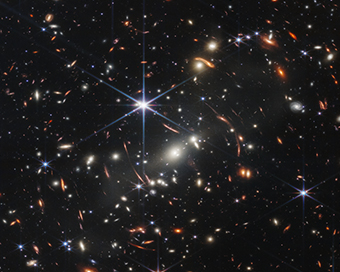Gallery
 PM Modi visit USA
PM Modi visit USA Only the mirror in my washroom and phone gallery see the crazy me : Sara Khan
Only the mirror in my washroom and phone gallery see the crazy me : Sara Khan Karnataka rain fury: Photos of flooded streets, uprooted trees
Karnataka rain fury: Photos of flooded streets, uprooted trees Cannes 2022: Deepika Padukone stuns at the French Riviera in Sabyasachi outfit
Cannes 2022: Deepika Padukone stuns at the French Riviera in Sabyasachi outfit Ranbir Kapoor And Alia Bhatt's Wedding Pics - Sealed With A Kiss
Ranbir Kapoor And Alia Bhatt's Wedding Pics - Sealed With A Kiss Oscars 2022: Every Academy Award Winner
Oscars 2022: Every Academy Award Winner Shane Warne (1969-2022): Australian cricket legend's life in pictures
Shane Warne (1969-2022): Australian cricket legend's life in pictures Photos: What Russia's invasion of Ukraine looks like on the ground
Photos: What Russia's invasion of Ukraine looks like on the ground Lata Mangeshkar (1929-2022): A pictorial tribute to the 'Nightingale of India'
Lata Mangeshkar (1929-2022): A pictorial tribute to the 'Nightingale of India' PM Modi unveils 216-feet tall Statue of Equality in Hyderabad (PHOTOS)
PM Modi unveils 216-feet tall Statue of Equality in Hyderabad (PHOTOS)Hockey India has announced a 54-member core probable squad for the upcoming senior men’s
- Satwik-Chirag return as BAI names 14-strong squad for BWF Sudirman Cup Finals 2025
- Men’s Sr Hockey Nationals to be played in division-based format from April 4
- Mensik denies Djokovic 100th title in Miami final
- KIPG: Son of a vegetable vendor, Bihar’s Jhandu Kumar eyes Worlds, 2028 Paralympics
- Hardik Singh credits hard work and team unity for receiving HI Midfielder of the Year award
James Webb Space telescope delivers first view of deepest infrared image of Universe Last Updated : 12 Jul 2022 12:42:27 PM IST 
James Webb Space Telescope has produced the deepest and sharpest infrared image of the distant universe to date.
The $10 billion Webb telescope, is an international programme led by NASA, European Space Agency and the Canadian Space Agency.US President Joe Biden unveiled this image of galaxy cluster SMACS 0723, known as Webb's First Deep Field, during a White House event on Monday.Thousands of galaxies -- including the faintest objects ever observed in the infrared -- have appeared in Webb's view for the first time. The image of the vast universe covers a patch of sky approximately the size of a grain of sand held at arm's length by someone on the ground.The release marks the climax of nearly seven months of carefully orchestrated space operations since the telescope launched on December 25, 2021.The telescope spent its first month after blast off trekking out to its station in orbit around what's called Earth-sun Lagrange point 2, nearly 1 million miles (1.5 million kilometres) away from Earth on the side opposite the sun.Taken by Webb's Near-Infrared Camera (NIRCam), the image is among the telescope's first-full colour images.It is a composite made from images at different wavelengths, totalling 12.5 hours -- achieving depths at infrared wavelengths beyond the Hubble Space Telescope's deepest fields, which took weeks.The image shows the galaxy cluster SMACS 0723 as it appeared 4.6 billion years ago. The combined mass of this galaxy cluster acts as a gravitational lens, magnifying much more distant galaxies behind it.Webb's NIRCam has brought those distant galaxies into sharp focus -- they have tiny, faint structures that have never been seen before, including star clusters and diffuse features. Researchers will soon begin to learn more about the galaxies' masses, ages, histories, and compositions, as Webb seeks the earliest galaxies in the universe.Webb telescope is the world's premier space science observatory. It aims to solve mysteries in our solar system, look beyond distant worlds around other stars, and probe the mysterious structures and origins of our universe and our place in it.IANS Washington For Latest Updates Please-
Join us on
Follow us on








172.31.16.186







